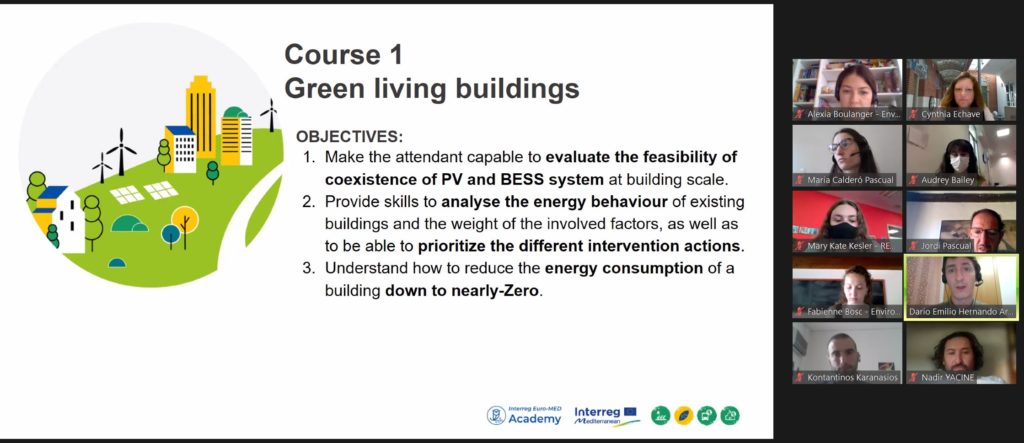Green Living Buildings course: renewable energy production in the city
The Interreg Euro-MED Academy Green Living Buildings course recently concluded its first edition. As the first course in the three-part learning programme, ‘Achieving green living areas, from buildings to cities and territories’, the two-week course was interactive, informative, user-friendly, and free.

The Green Living Buildings course was launched on June 10. Emilio Hernando – researcher at IREC – described the course as an opportunity to ‘take wider intervention actions’ in sustainable building. In the launch event, participants were given descriptions of three challenges to choose from: Integrate Self-Sufficient Energy Facilities, Achieve Best Energy Investment, and Maximise the Energy Efficiency in Your Building. After being introduced to the challenges, participants chose their preferred one and discussed it with other participants and members of the educational team in breakout rooms.
One of the course challenges was focused on energy consumption in schools in the Mediterranean region. The objective of this challenge was to learn how to lower a school’s energy consumption to nearly zero. In order to understand the factors that impact a school’s energy consumption, participants used TEESCHOOLS, a web tool that allows stakeholders and teachers to simplify the process of calculating energy use and develop an initial draft of what changes can be made to lower energy consumption. After inputting the required information into TEESCHOOLS, users can download the results as a PDF. The instructors explained that by doing this, users are ‘able to see how each energy intervention contributes to the total energy saved’.

After the course launch, participants were able to access the e-lessons for their selected challenges on the Interreg Euro-MED Academy platform. For example, a student could click on ‘maximise the energy efficiency in a building’ and find five video e-lessons explaining in detail how to use the TEESCHOOLS module to complete the challenge. After each video, the lesson was clearly summarised in written format. Once viewing all videos and reading the lesson summaries, participants took a short self-evaluation consisting of six multiple-choice questions. These questions helped participants check their knowledge and remember the most important takeaways from the challenge.
Participants also had the option of applying what they learned from the e-lessons to create a pitch. After completing the challenge and creating a presentation, they could present their pitch at the closing session on June 27. Nadir Yacine, a participant in the ‘Integrate Self-Sufficient Energy Facilities’ challenge, chose to present his pitch to the group. His two mentors for the challenge were very pleased with the results and his progress as well as the participation of other students. It was also revealed at the end of this meeting that all participants now have full access to all three challenges. This way, each person enrolled in the Green Living Buildings course can learn about sustainable building from different perspectives using various technological approaches.
Cynthia Echave – Project Coordinator, Euro-Mediterranean Economist Association (EMEA) – expressed in the launch of the course that ‘the main objective in this learning programme will enable [you] to synthesise [lessons] and make them easy to apply to your projects, plans, etcetera’. Participants are certainly on track to achieve this goal, for the Green Living Buildings Course has already helped them apply practical knowledge and collaborate with experts in the field of sustainable building.

Green Living Buildings: first course of the Green Living Areas learning programme
The Green Living Areas learning programme also began on June 10 with an engaging online launching event. Cynthia Echave – Project Coordinator, Euro-Mediterranean Economist Association (EMEA) – introduced the programme and thanked participants for their participation and commitment. Echave emphasised that the programme is organised to help participants see ‘how you are going to link the courses at the end’. Emilio Hernando – Researcher, IREC – explained the first course, Laia Vinyes – Project Officer, MedCities – explained the second course focused on cities, and Maria Calderó – Project Manager, Beta Tech Centre – explained the third course that puts the focus on the areas outside the cities.
Alexia Boulanger – Senior Specialist, Environment Park – briefly went over each of the challenges and demonstrated how to access them on the programmes’s website. As for the programmes’s structure, the instructors and organisers clearly explained that it is comprised of three courses: green living buildings, green living cities, and green living territories. To help participants use the information from the lessons and collaborate with others, there were relevant challenges in each course.
To wrap up the launch, Jordi Pascual – Postdoctoral Researcher, IREC – left the participants with a gracious reflection. Pascual said, ‘When we were planning this, it was a challenge. But we were aware that we need to face society’s current challenges and share knowledge with third parties (…) it requires that we are all in the same boat’. Alluding to the most pressing environmental issues of our time, Pascual and Echave finished the launch on a hopeful note by reiterating the importance of sharing crucial knowledge and facilitating collaboration between people in environmental fields.